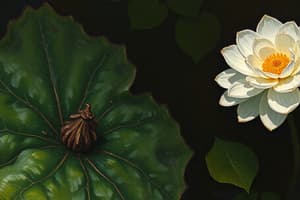Podcast
Questions and Answers
Which characteristic of living organisms is primarily responsible for their ability to maintain a stable internal environment?
Which characteristic of living organisms is primarily responsible for their ability to maintain a stable internal environment?
- Reproduction
- Growth and Development
- Adaptation
- Homeostasis (correct)
What process do producers use to convert sunlight into usable energy?
What process do producers use to convert sunlight into usable energy?
- Decomposition
- Respiration
- Metabolism
- Photosynthesis (correct)
In the energy flow of ecosystems, who primarily utilizes sugars released by consumers?
In the energy flow of ecosystems, who primarily utilizes sugars released by consumers?
- Producers
- Photosynthetic organisms
- Decomposers (correct)
- Primary consumers
Which of the following best describes prokaryotic cells?
Which of the following best describes prokaryotic cells?
Which level of biological organization directly follows cells in the hierarchy of life?
Which level of biological organization directly follows cells in the hierarchy of life?
What is the primary energy-carrying molecule produced during respiration in consumers?
What is the primary energy-carrying molecule produced during respiration in consumers?
Which process describes the change of populations over time to better suit their environment?
Which process describes the change of populations over time to better suit their environment?
Which of the following is NOT a characteristic of living organisms?
Which of the following is NOT a characteristic of living organisms?
What is the main consequence of sexual reproduction compared to asexual reproduction?
What is the main consequence of sexual reproduction compared to asexual reproduction?
Which of the following mechanisms is essential for maintaining homeostasis?
Which of the following mechanisms is essential for maintaining homeostasis?
What is the primary role of natural selection in evolution?
What is the primary role of natural selection in evolution?
In taxonomy, which category follows 'kingdom' in the hierarchical classification system?
In taxonomy, which category follows 'kingdom' in the hierarchical classification system?
Why is biodiversity important to ecosystems?
Why is biodiversity important to ecosystems?
How does asexual reproduction primarily differ from sexual reproduction?
How does asexual reproduction primarily differ from sexual reproduction?
What is an example of an adaptation in organisms?
What is an example of an adaptation in organisms?
What is the significance of understanding biological processes in addressing global challenges?
What is the significance of understanding biological processes in addressing global challenges?
Flashcards
Natural Selection
Natural Selection
The process by which organisms with traits better suited to their environment are more likely to survive and reproduce.
Asexual Reproduction
Asexual Reproduction
A type of reproduction involving a single parent, resulting in offspring genetically identical to the parent.
Homeostasis
Homeostasis
The ability of an organism to maintain a stable internal environment despite external fluctuations.
Evolution
Evolution
Signup and view all the flashcards
Taxonomy
Taxonomy
Signup and view all the flashcards
Sexual Reproduction
Sexual Reproduction
Signup and view all the flashcards
Diversity of Life
Diversity of Life
Signup and view all the flashcards
Adaptation
Adaptation
Signup and view all the flashcards
What is a cell?
What is a cell?
Signup and view all the flashcards
What are producers?
What are producers?
Signup and view all the flashcards
What is respiration?
What is respiration?
Signup and view all the flashcards
What is homeostasis?
What is homeostasis?
Signup and view all the flashcards
What is the organization of life?
What is the organization of life?
Signup and view all the flashcards
What is an ecosystem?
What is an ecosystem?
Signup and view all the flashcards
What is the difference between prokaryotic and eukaryotic cells?
What is the difference between prokaryotic and eukaryotic cells?
Signup and view all the flashcards
What is adaptation?
What is adaptation?
Signup and view all the flashcards
Study Notes
Characteristics of Living Organisms
- Living organisms exhibit a set of shared traits that differentiate them from non-living things.
- These characteristics include:
- Organization: Living things possess complex internal structures, built from cells.
- Metabolism: Organisms carry out chemical reactions to acquire energy and build/break down molecules.
- Growth & Development: Living things increase in size and complexity during their life cycles.
- Adaptation: Populations change over time to better fit their environments.
- Response to Stimuli: Living things react to changes in their surroundings.
- Reproduction: Organisms create new similar organisms.
- Homeostasis: Maintaining a constant internal environment despite external changes.
Cellular Basis of Life
- Cells are the fundamental structural and functional units of living organisms.
- All organisms are made of one or more cells.
- Two major categories of cells exist: prokaryotic and eukaryotic.
- Prokaryotic cells:
- Lack a nucleus and membrane-bound organelles.
- Generally smaller and simpler than eukaryotic cells.
- Found in bacteria and archaea.
- Eukaryotic cells:
- Contain a nucleus and membrane-bound organelles.
- Generally larger and more intricate than prokaryotic cells.
- Found in protists, fungi, plants, and animals.
Energy Flow in Ecosystems
- Organisms constantly need energy to carry out life's functions.
- Energy flows unidirectionally through ecosystems, usually starting from the sun and moving through producers to consumers.
- Photosynthesis: Producers (plants, algae) use sunlight to convert carbon dioxide and water into sugars (glucose), a primary energy source.
- Respiration: Consumers (animals, fungi) break down sugars to release energy in the form of ATP (adenosine triphosphate).
- Food chains and food webs depict energy flow within ecosystems.
Organization of Life
- Matter and energy are organized hierarchically in living systems:
- Atoms combine to form molecules.
- Molecules form macromolecules (carbohydrates, proteins, lipids, nucleic acids).
- Macromolecules form organelles.
- Organelles form cells.
- Cells form tissues.
- Tissues form organs.
- Organs form organ systems.
- Organ systems form organisms.
- Organisms form populations.
- Populations form communities.
- Communities and their environment create ecosystems.
- All ecosystems together constitute the biosphere.
Reproduction
- Reproduction is essential for species continuity.
- Two main types of reproduction exist: asexual and sexual.
- Asexual reproduction:
- Involves a single parent.
- Offspring are genetically identical to the parent.
- Examples include binary fission, budding, fragmentation.
- Sexual reproduction:
- Involves two parents.
- Offspring inherit genetic material from both parents; leading to variation.
- Examples include fertilization of sperm and egg, meiosis, and mitosis.
Evolution
- Evolution is the change in heritable traits within biological populations across generations.
- Driven by natural selection.
- Natural selection: Organisms with advantageous traits are more likely to survive and reproduce in a specific environment.
- Adaptation: Traits enhancing survival and reproduction in a given environment.
Homeostasis
- Homeostasis is the ability of an organism to maintain a stable internal environment despite environmental changes.
- Crucial for processes such as:
- Body temperature regulation.
- Blood glucose level maintenance.
- Blood pH adjustment.
- Feedback mechanisms are essential for homeostasis.
Classification of Life
- Taxonomy classifies organisms into groups.
- A hierarchical system uses broader categories:
- Domains (Bacteria, Archaea, Eukarya)
- Kingdoms
- Phyla
- Classes
- Orders
- Families
- Genera
- Species.
- Evolutionary relationships are fundamental to classification.
Diversity of Life
- Organisms exhibit a vast range of forms and functions.
- Different species have evolved to fill various ecological roles (niches).
- Examples of diversity include:
- Variety of plant structures.
- Adaptations of animals for diverse habitats.
- Functional differences among organisms.
The Importance of Biology
- Understanding biological processes is critical for tackling global challenges.
- Examples include:
- Disease solutions.
- Sustainable agriculture development.
- Biodiversity protection.
- Climate change impact understanding.
- Human health improvement.
- Resource conservation.
Studying That Suits You
Use AI to generate personalized quizzes and flashcards to suit your learning preferences.
Description
This quiz explores the fundamental characteristics that define living organisms. It covers topics such as organization, metabolism, growth, adaptation, and reproduction. Test your understanding of how these traits contribute to life and differentiate living beings from non-living matter.




